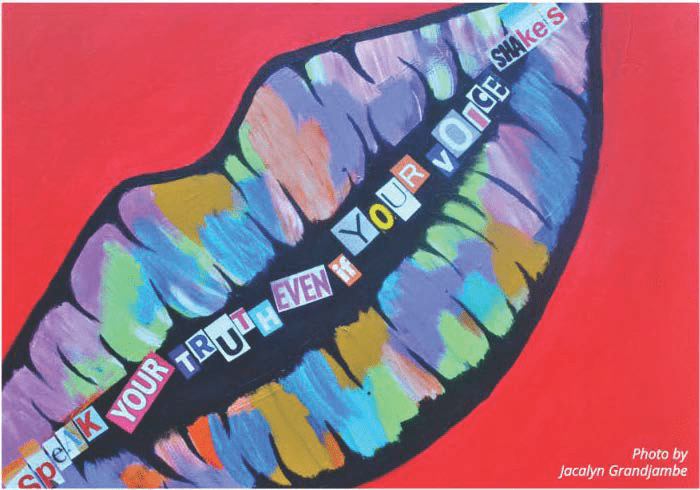Bullying is about the abuse of power. Over time, the abuse creates a sense of Isolation In the target and is intended to silence both the target and the bystander. Story telling Is essential to returning our voices.
OUR VOICES WILL BE HEARD
For those who have experienced lateral violence* and/or other forms of bullying. the abuse has likely continued for 6 months to several years. We often see generational bullying and recognize that many layers are involved; this complexity harms the target even further. Bullying behaviors have been normalized for far too long. More often the target Is the person who is blamed for the conflicts that arise. Over time, many targets suffer from anxiety, self doubt, feelings of being stuck, hopelessness, and confusion.
Story telling in a safe, confidential, and supportive environment is a crucial step In recovery. Story telling allows a target or bystander to develop clarity around their personal experiences of bullying. Without this clarity, fear, anxiety, and low self confidence will continue to block their ability to heal.
CLARITY EVOLVES FROM STORY TELLING
- When overwhelmed with emotions and thoughts, writing your story out first will help release blocked energy. Even if the timelines are out
of order, keep writing. This will allow the wisdom already within you to once again come through. It will make sense in time. - When the puzzle in your mind begins to take form and show the full picture, you are able to begin the healing process. Though this may feel painful, it helps to validate your experience and overcome feelings of confusion, and fear of the unknown. This fear and confusion Is what keeps you silent.
- Sharing your story out loud, with those you trust most, will allow others opportunity to give you validation. Discovering that you are not alone will support your recovery.
- With each step taken, a sense of grounding begins to take place. This grounding empowers you and gives you more strength to continue on to the next steps in the healing process.
- Sharing your story will increase your confidence and your sense of self worth. You will control what, where, when and with whom you will share your Information.
- Developing clarity in your story will save yourself time & money if you choose to share your story with your medical team, human resources, insurance companies, counsellors and/or other professionals.
- Sharing your story will help improve your mood and your health.
STORY TELLING RESTORES OUR POWER
A few suggestions to support you further:
- A counsellor can support you through the stages of forming your story. Though this can be an emotional process, having someone to support you as you walk this Journey may be the safety net you find most comforting.
- Depending on your circumstances, sharing your story with a therapist may only require 1 – 2 sessions. Others may need much more time, but no matter how long it takes, you deserve this type of support and comfort.
- Feel free to use creativity when discovering and/or sharing your story. Use whatever method best resonates with you: such as paint, crafts, photos, music or audio recording yourself as you read your story.
WHEN THE STORY IS READY WE FIND OUR VOICE AGAIN
After you have clarified your story, try the following in this order:
a) Some people find it helpful to make an audio/video recording as they tell their own story. Some do this alone and keep the recording for themselves, while others may choose to share It. If you choose to do a recording, but find the process difficult, just remember to take healthy breaks: for example, a walk in nature, meditation, sleep, or enjoying time with your family.
b) Next choose someone you trust and respect to share your story with; choose someone who will support you 1 00%. For example, an elder, a loved one or a professional counsellor. Explore the experience of reading your story to them. You can also ask your trusted support to read your story to you.
Feel free to share parts of your story at instituteofworkplacebullyingresources.ca. You control all the material you share. Many of us feel this is part of the Justice we need. Though we remove the names and any identifiers, the story is no longer a secret. There is satisfaction and a sense of justice when we can share our stories and we can help others feel that they are not alone.
*Lateral Violence: is bullying between peers (equols) In their workploce status. This abuse occurs In all cultures and describes the way people in positions of powerlessness, covertly or overtly direct their dissatisfaction inward toward each other, toward themselves, and toward those less powerful than themselves.
Please note that this article is a general overview. Each case of bullying is unique therefore this is not intended to provide personalized advice on how to deal with workplace bullying, lateral violence and/or mobbing, and is not intended as a solicitation to purchase services from the author. Linda R. Crocket, MSW, RSW President of the CIWBR is solely responsible for its content For more in-depth Information on the topics of bullying and/or harassment please contact a qualified professional with the appropriate credentials, experience and references.
By Linda Crockett
Originally published in the ABORIGINAL WOMEN’S ECONOMIC QUARTERLY, WINTER 2015


